

Mini-Gun
M134 7.62mm Machine Gun "Minigun"
(GAU-2.A U.S. Air Force and GAU-17/A U.S. Navy)
Email input - Meeks, Whitehead, Dooling, Betsill, Karn
see XM21 Conversion Discussion and LOH Left Side mount Discussion
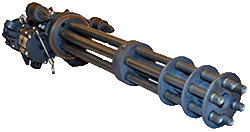 Length—31.5 inches.
Length—31.5 inches.
Weight—60 pounds, including drive motor and delinking feeder.
Muzzle Velocity—2,750 feet per second.
Rate of Fire—variable from 1,000 to 6,000 rounds per minute.
Ammunition—NATO M61 Armor Piercing; NATO M80 Ball; and NATO M62 Tracer.
With the increasing involvement of the United States in Vietnam by 1960, engineers at General Electric’s Armament Division began developing plans for an electric-powered, rotating barrel Gatling-style weapon primarily to meet the need of helicopters requiring overwhelming suppressive fire during landing operations.
Designers, using as a model a devastating weapon the corporation fielded for the U. S. Air Force in 1959, scaled down the rotating-barrel GAU-4 20MM (M61 VULCAN) CANNON to create the M134 7.62MM MACHINE GUN. Entering service in 1963, the American military quickly embraced the weapon as the "Minigun." Arriving in country beginning in 1964, over 10,000 of these weapons were produced during the Vietnam War and with an Army Standard rate fire from 2,000 to 4,000 rounds per minute, the "Minigun" attained legendary status among aviators, with models still in use today.
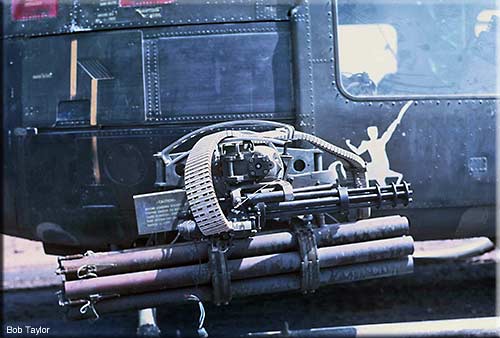
The Centaurs accepted delivery of the M134s for the UH-1C Heavy Scouts as part of the XM21 ARMAMENT SUBSYSTEM mounting Miniguns each side with 7-tube 2.75-inch rocket pods that phased out the old M16 ARMAMENT SUBSYSTEM of quad M60Cs paired with 7-tube pods.
(photo Bob Taylor slideshow)
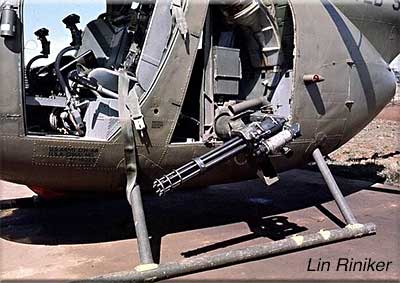
Coinciding with the 1967 Vietnam introduction of the OH-6A Cayuse Light Observation Helicopter, or Loach to all who came to know and love them, combat testing of experimental armament subsystems were utilized with mixed reviews, including the M27 ARMAMENT SUBSYSTEM. This mounted one 7.62mm Minigun on the left side and a 2,000 round ammunition box installed behind the pilot with flexible chute feeding ammunition to the gun. Due in part to airframe stress cracks and rate of fire problems, this system, as well as other mounted weapons, were discarded in favor of gunners with modified M60s (Photo Album of Linford E. Riniker).
The AH-G Cobra Gunship arrived in Vietnam in August 1967 and entered combat the following month armed with the TAT102A Nose Turret mounting one 7.62 Minigun with 2,000 rounds, and wing store armament consisting of two XM18 MINIGUN PODS carrying 1,500 rounds internally, installed inboard each side and two XM200 19-tube 2.75 inch rocket pods mounted outboard.
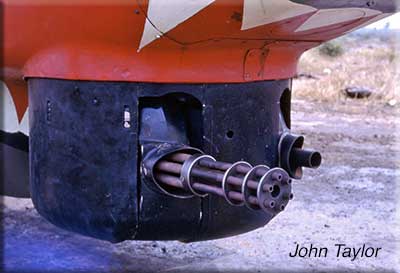 When the Centaurs accepted delivery of the first Cobra in June 1968, standard equipment included the new dual weapon M28A1 Turret with “B,” or Hybrid, configuration of right hand minigun and left hand 40mm Grenade Launcher. The Centaurs experimented with the "A" configuration of twin Miniguns but experienced jamming issues with the left hand Minigun caused by the feeder-delinker being mounted upside down.
When the Centaurs accepted delivery of the first Cobra in June 1968, standard equipment included the new dual weapon M28A1 Turret with “B,” or Hybrid, configuration of right hand minigun and left hand 40mm Grenade Launcher. The Centaurs experimented with the "A" configuration of twin Miniguns but experienced jamming issues with the left hand Minigun caused by the feeder-delinker being mounted upside down.
The cylindrical ammunition drum assembly could provide 4,000 rounds for the Minigun, but became notorious for jamming malfunctions and damage to the flex drive cable when the drum was fully loaded. Armorers remedied the problem by reverting to the older 2,000 round ammunition boxes that eliminated the need for the flex drive cable system, as well as aircraft down time.

The XM-18 Minigun Pods were an option for the inboard stores. This completely integrated weapon system, originally designed for high-speed aircraft, contained its own power source to operate the electrically driven fixed M134 Minigun, and ammunition was fed by the gun motor through a linkless system to the weapon from a 1,500 round drum contained in the rear of the pod. Later models of the pod were adapted to plug into the aircraft power system but due in part to the lower rate of fire for helicopter use, the system was plagued with ammunition feed problems and was eventually replaced by more rockets (Photo Album of Jack M. Nemeyer, 1969-1970, Image 40/63).
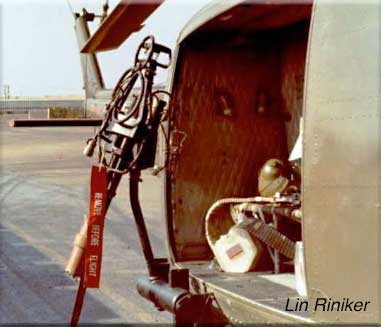
Centaur commanders installed modified M59 Armament Subsystems on their Command and Control UH-1s in response to ground fire while directing operations from altitude. This system pintle mounted the M2 .50-CALIBER BROWNING MACHINE GUN in the left side door with an M60D pintle mounted right door. Centaur C&C aircraft installed a modified hand operated M134 7.62 Minigun in place of the M60. Power to the drive motor was provided through the aircraft electrical system by plug-in and ammunition was delivered through flexible chute attached to a 2,000 round ammunition box. Although effective in suppressing enemy gunfire, the system eventually proved to be detrimental to the aircraft resulting in stress cracks in the airframe and tail boom (Photo Album of Linford E. Riniker).
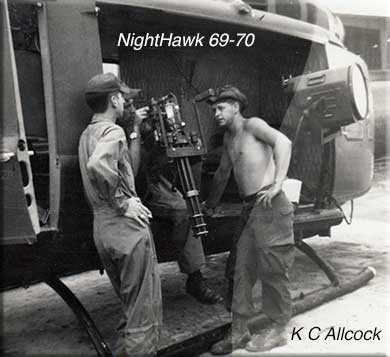
photo by Allan K.C.Allcock
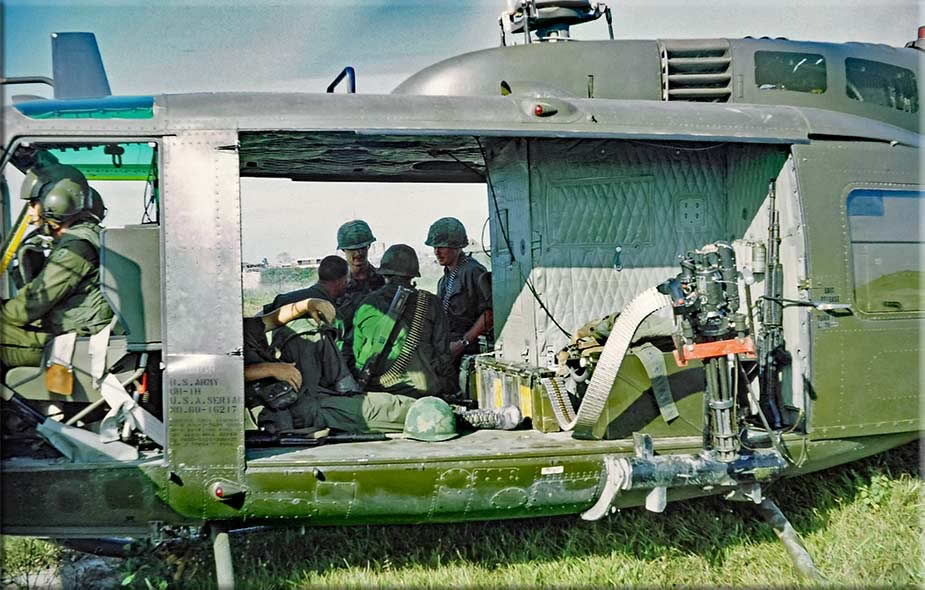
photo by Stan Allen
REFERENCES
https:/en.wikipedia.org/wiki/Minigun
ST 23-2 Aircraft Armament Subsystem Photographs and Description, U.S. Army Armor School, Ft. Knox, Kentucky (May 1976).
TM 9-1090-203-12, Operator and Organizational Maintenance Manual: Armament Subsystem Helicopter, 7.62mm Machine Gun—40mm Grenade Launcher: M28A1 (1090-00-134-3071) (used on AH-1G Helicopter) Headquarters, Department of the Army (January 1976).Winged Sabers, The Air Cavalry in Vietnam, Lawrence H. Johnson III, Stackpole Books (1990).
Vietnam Choppers and Their Crews, Jonathan Bernstein and Gordon Rottman, Osprey Publishing Ltd. (2007).
Vietnam Order of Battle, Shelby L. Stanton, U. S. News Books (1986).
Vietnam, The Helicopter War, Philip D. Chinnery (1991).
6Aug2017 Tom Meeks CW2 Cobra Pilot (1967-68)… We did have some of the XM18 mini gun pods. Not sure how many but I used them on one of the first aircraft we had. We didn’t use them long because they jammed all the time and there was no way to work on them in flight. Couple other problems: They had a habit of “running away” after a firing run and the ammo in them didn’t last usually past a single gun run. The only way to secure them was to pull the circuit breaker. After a couple of flights we took them off the aircraft I flew and installed rocket pods. Not sure what happened to them after that. Side note: I know one of the tech reps we had looked at the problem but had no fix other that to clear them on the ground and try again.
6Aug2017 John Whitehead CPT Cobra Pilot (1968-69) I remember The items you speak of (XM-19). I had two of them mounted inboard on my Cobra. I remember no one else wanted to give up 38 Rockets (two 19 tube pods) for the mini gun.
20Jun2019 Sam Dooling CW2 Cobra and Scout pilot (1969-70): In early 1969 we had one Cobra with dual miniguns (551) and one with dual 40MM (540). The dual minis were pretty cool, but the 40s never seemed to work right - had feeding problems with the right hand one, so both aircraft were eventually returned to the standard configuration.
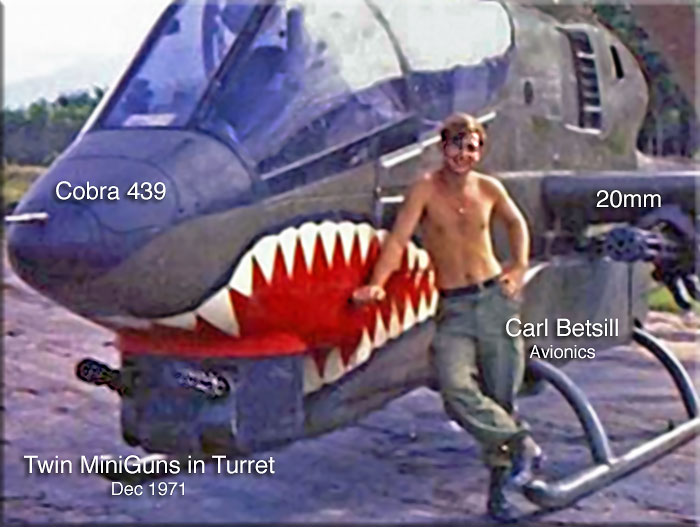
23Jun2019 Carl Betsill SP4 Avionics reminds us of the twin miniguns on Cobra 439 in Dec 1971. Also see History 20mm.
3 Mar 2020 Bruce Karn: For a short period of time we had two LOH aircraft equipped with a mini-gun door gun for the crew chief. A frame was made for the gun and then it was mounted on the right jacking point and braced back inside. At 2,000 rounds per minute it wasn't too difficult to hold onto but at 4,000 it was a handful! Only adrenaline would enable the CE to handle the high rate.